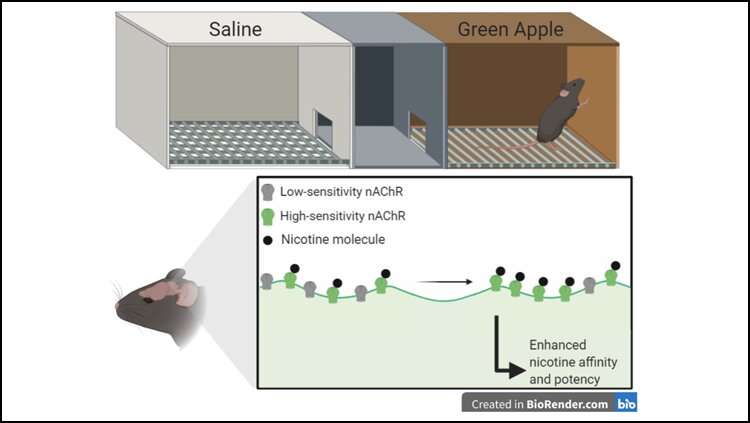The green apple vape flavorant, farnesene, is rewarding in mice as demonstrated through a three-chamber Pavlovian choice behavioral task. Green apple promotes the inclusion of high-sensitivity nicotinic receptors to a greater extent than low-sensitivity receptors. This enhances nicotine's impact in brain regions that are critical in nicotine addiction. Credit: Cooper et al., eNeuro 2020
A common green apple vape flavor enhances nicotine reward and is also rewarding itself, according to research in mice recently published in eNeuro.
Vaping entices adolescents into nicotine use with fun flavors like green apple and cotton candy. Nicotine-free flavored vapes have also gained popularity. But of the over 7000 available flavor chemicals, only a handful have been studied. With or without nicotine, flavored vapes pose potential risks for the brain, including addiction.
To continue unraveling these risks, Cooper et al. gave mice either nicotine, the green apple flavorant farnesene, or both in one chamber and a saline solution in another. Farnesene was rewarding by itself, as mice chose the farnesene chamber over the saline chamber. But farnesene also enhanced reward when combined with nicotine.
The research team next measured how farnesene changed nicotine receptor expression and neuron activation. Alone, farnesene partially activated nicotinic receptors, meaning it may increase nicotine's receptor activation when both substances are present. Farnesene also increased the proportion of high- to low-sensitivity receptors. A greater proportion of high-sensitivity receptors increases the effects of a standard nicotine dose, which could heighten reward and drug-seeking behavior. Despite their marketing, vape flavors are not risk-free and may exacerbate the effects of nicotine.
More information: Green Apple E-Cigarette Flavorant Farnesene Triggers Reward-Related Behavior by Promoting High-Sensitivity nAChRs in the Ventral Tegmental Area, eNeuro, DOI: 10.1523/ENEURO.0172-20.2020
Provided by Society for Neuroscience
























